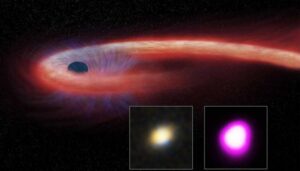
New deep-space research has concluded that black holes are consuming stars at an alarming rate, way faster than astronomers previously thought.
A brand new study has found that supermassive black holes lurk in dark regions of space, always ready to trap nearby stars and slowly consume their matter, a la galactic Venus Flytrap.
This phenomenon was well known, but it is the frequency at which it happens that has stunned the research community at the University of Sheffield, the conductors of the study.
A black hole is an anomaly created when a celestial body, usually a star, runs out of fuel and collapses unto itself under the force of gravity. Eventually, gargantuan amounts of matter are compressed into a relatively small area of space, creating a super-dense region with such colossal gravitational pull that not even light can escape. It is because of this trait that black holes are only revealed through special equipment and by observing the surrounding space.
When a star wanders in the vicinity of one of these cosmic monsters, it becomes trapped in an inescapable gravitational pull, slowly dwindling away as the black hole swallows it whole.
In scientific terms, such predation is called a Tidal Disruption Event (TDE). Prior knowledge stated that one such event would happen once every 10,000 to 100,000 years per galaxy.
However, it has now transpired that TDEs occur about 100 times more often, particularly as galaxies collide with one another.
TDEs are exceptionally violent episodes of utter chaos at cosmic level, with devastating consequences. When galaxies collide, their structure warps, ripping stars out of their orbits, and often throwing them into the ravenous maws of lurking black holes. The outcome of such cataclysmic events is a single, enormous new galaxy risen from the remnants of the two colliding titans.
And the bad news is that our very own galactic home, the Milky Way, is on an inexorable collision course with Andromeda, the closest spiral galaxy. This end-of-days event will happen in about 5 billion years though, so don’t go making plans for your TDE blaze of glory party just yet.


